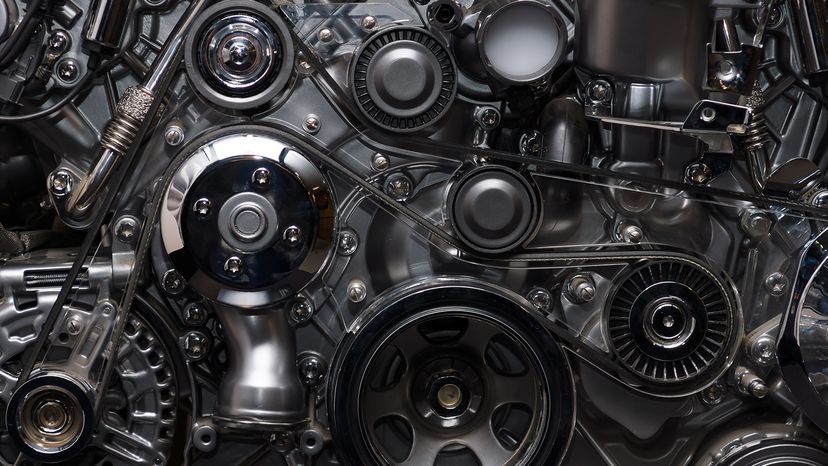
You see gears in just about everything that has spinning parts. For example, car engines and transmissions contain lots of gears. If you ever open up a VCR and look inside, you will see it is full of gears. Wind-up, grandfather and pendulum clocks contain plenty of gears, especially if they have bells or chimes. You probably have a power meter on the side of your house, and if it has a see-through cover, you can see that it contains 10 or 15 gears.
Gears are everywhere where there are engines and motors producing rotational motion. Read on to learn about gears, gear ratios and gear trains so that you can understand what all the different gears you see are doing.
Advertisem*nt
Contents
- What Does a Gear Do?
- Understanding the Concept of the Gear Ratio
- The Purpose of Gear Teeth
- Gear Trains
- Other Uses for Gears
- An Example
What Does a Gear Do?
Gears are generally used for one of four different reasons:
- To reverse the direction of rotation
- To increase or decrease the speed of rotation
- To move rotational motion to a different axis
- To keep the rotation of two axes synchronized
Advertisem*nt
Understanding the Concept of the Gear Ratio
Understanding the concept of the gear ratio is easy if you understand the concept of the circumference of a circle. Keep in mind that the circumference of a circle is equal to the diameter of the circle multiplied by pi (pi is equal to 3.14159...). Therefore, if you have a circle or a gear with a diameter of 1 inch, the circumference of that circle will be 3.14159 inches.
Let's say that you had two circles: one with a diameter of 1.27 inches and another with a diameter of 1.27 inches / 2 = 0.635 inches. The larger of the two circles has a circumference of 4 inches.
Advertisem*nt
If you rolled both circles, you would find that the smaller one has to complete two full rotations to cover the same 4-inch line as the larger one. This explains why two gears — one half as big as the other — have a gear ratio of 2:1. The smaller gear has to spin twice to cover the same distance covered when the larger gear spins once.
The Purpose of Gear Teeth
Most gears that you see in real life have teeth. The teeth have three advantages:
- They prevent slippage between the gears. Therefore, axles connected by gears are always synchronized exactly with one another.
- They make it possible to determine exact gear ratios; you just count the number of teeth in the two gears and divide. So if one gear has 60 teeth and another has 20, the gear ratio when these two gears are connected together is 3:1.
- They make it so that slight imperfections in the actual diameter and circumference of two gears don't matter. The number of teeth control the gear ratio, even if the diameters are a bit off.
Advertisem*nt
Gear Trains
To create large gear ratios, gears are often connected together in gear trains, as shown here:
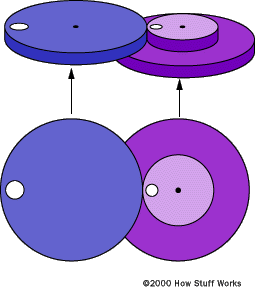
The right-hand (fuchsia) gear in the train is actually made in two parts, as shown. A small gear and a larger gear are connected together, one on top of the other. Gear trains often consist of multiple gears in the train, as shown in the following two figures:
Advertisem*nt
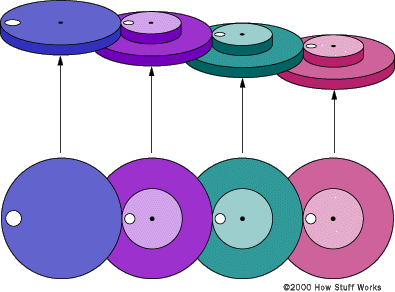
In the case above, the fuchsia gear turns at a rate twice that of the purple gear. The green gear turns at twice the rate as the fuchsia gear. The pink gear turns at twice the rate as the green. The gear train shown below has a higher gear ratio:
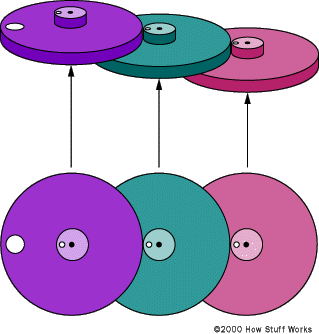
In this train, the smaller gears are one-fifth the size of the larger gears. That means that if you connect the purple gear to a motor spinning at 100 rpm (revolutions per minute), the green gear will turn at a rate of 500 rpm and the pink gear will turn at a rate of 2,500 rpm.
In the same way, you could attach a 2,500 rpm motor to the pink gear to get 100 rpm on the purple gear.
If you can see inside your power meter and it is of the older style with five mechanical dials, you will see that the five dials are connected to one another through a gear train like this, with the gears having a ratio of 10:1.
Because the dials are directly connected to one another, they spin in opposite directions (you will see that the numbers are reversed on dials next to one another). For more information on gear ratios, visit our gear ratio chart.
Advertisem*nt
Other Uses for Gears
There are many other ways to use gears. For example, you can use conical gears to bend the axis of rotation in a gear train by 90 degrees.
The most common place to find conical gears like this is in the differential of a rear-wheel-drive car. A differential bends the rotation of the engine 90 degrees to drive the rear wheels:
Advertisem*nt
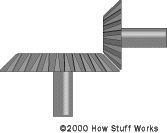
Another specialized gear train is called a planetary gear train. Planetary gears solve the following problem. Let's say you want a gear ratio of 6:1. One way to create that ratio is with the following three-gear train:
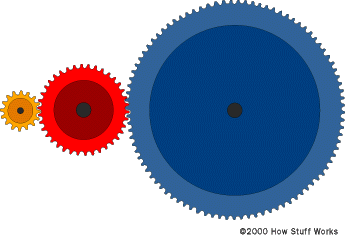
In this train, the red gear has three times the diameter of the yellow gear, and the blue gear has two times the diameter of the red gear (giving a 6:1 ratio).
However, imagine that you want the axis of the output gear to be the same as that of the input gear. A common place to need this same-axis capability is in an electric screwdriver. In that case, you can use a planetary gear system, as shown here:
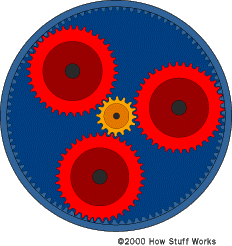
In this gear system, the yellow gear engages all three red gears simultaneously. They are all three attached to a plate, and they engage the inside of the blue gear instead of the outside.
Because there are three red gears instead of one, this gear train is extremely rugged. The ouput shaft is taken from the plate, and the blue gear is held stationary. You can see a picture of an two-stage planetary gear system on the electric screwdriver page.
Advertisem*nt
An Example
Finally, imagine the following situation: you have two red gears that you want to keep synchronized, but they are some distance apart. You can place a big gear between them if you want them to have the same directions of rotation:
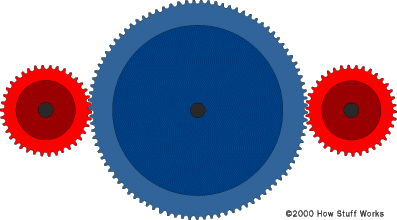
Or you can use two equal-sized gears if you want them to have opposite rotational direction:
Advertisem*nt

However, in both of these cases the extra gears are likely to be heavy and you need to create axles for them. In these cases the common solution is to use either a chain or a toothed belt, as shown here:

The advantages of chains and belts are light weight, the ability to separate the two gears by some distance, and the ability to connect many gears together on the same chain or belt.
For example, in a car engine, the same toothed belt might engage the crankshaft, two camshafts and the alternator. If you had to use gears in place of the belt, it would be a lot harder!
Advertisem*nt
Gear Ratios FAQ
How do you calculate gear ratio?
You just count the number of teeth in the two gears and divide. So if one gear has 60 teeth and another has 20, the gear ratio when these two gears are connected together is 3:1.
Is it better to have a higher or lower gear ratio?
If you want better fuel mileage and less noise, then you will want a higher gear ratio.
What does 4.11 gear ratio mean?
This is an ideal gear ratio for everyday driving.
Do you want a higher or lower gear ratio?
If you want optimal towing capacity, then you're going to want a higher gear ratio of at least 4.56. Anything lower will be good for fuel economy and everyday driving.
Which gear ratio is best?
Depending on your vehicle and desired outcome, you should compare gear ratio with tire size. You can check out this HowStuffWorks chart to learn more.
You've landed in the fascinating world of gears, and I'm your guide through this intricate machinery landscape. Now, let's delve into the nitty-gritty of gears, gear ratios, and gear trains.
First off, let's talk about the fundamental functions of gears. Gears are the unsung heroes, silently working behind the scenes in various mechanisms. Whether it's the intricate dance of car engines, the rhythmic ticking of clocks, or the mesmerizing coordination of a power meter, gears play a crucial role.
Now, let's dissect the purposes of gears. Gears are versatile and can serve four primary functions:
-
Reversing Rotation: Ever wondered how rotational direction can be reversed? Gears are the answer.
-
Speed Control: Gears are the maestros orchestrating the speed of rotation, either cranking it up or dialing it down.
-
Axis Transition: Imagine a graceful waltz where rotational motion seamlessly shifts to a different axis—gears make it happen.
-
Synchronization: Gears are the conductors ensuring that two axes move in perfect harmony, avoiding any discord in the mechanism.
Moving on to the intriguing concept of the Gear Ratio. It's all about understanding the circumference of a circle, and trust me, it's easier than it sounds. Picture two circles—one with a diameter of 1.27 inches and another half its size. Roll them, and you'll witness the magic of gear ratios. The smaller gear completes two rotations for every one rotation of the larger gear, giving us a gear ratio of 2:1.
Now, let's zoom in on the unsung heroes of gears—their teeth. These tiny protrusions serve a trio of vital roles:
-
Preventing Slippage: Teeth ensure that axles connected by gears are perpetually synchronized, leaving no room for slippage.
-
Ratio Determination: Counting teeth becomes the key to precise gear ratios. For instance, if one gear boasts 60 teeth and its counterpart 20, the gear ratio is a clear 3:1.
-
Imperfection Tolerance: Teeth act as the arbitrators of imperfections, letting gears maintain their ratio even if diameters play a bit of hide and seek.
Gear trains, the ensemble of gears working in harmony, enter the stage next. Picture a captivating performance where gears interconnect, creating large gear ratios. A cascade of gears, each turning at a rate dictated by the one before, forms the mesmerizing gear train.
Now, let's explore the diverse applications of gears. Conical gears take a bow in the world of rear-wheel-drive cars, bending the axis of rotation by a cool 90 degrees. Planetary gear trains, the problem-solvers, ensure a gear ratio of 6:1 while keeping input and output axes aligned.
In a grand finale, consider the ingenious use of chains and belts. Light, versatile, and capable of connecting distant gears, they take center stage when extra gears become cumbersome.
So, whether you're captivated by the intricate dance of gears in a car engine or the synchronized spin of your power meter's dials, gears are the unsung heroes of rotational motion, weaving a tapestry of mechanical marvels.